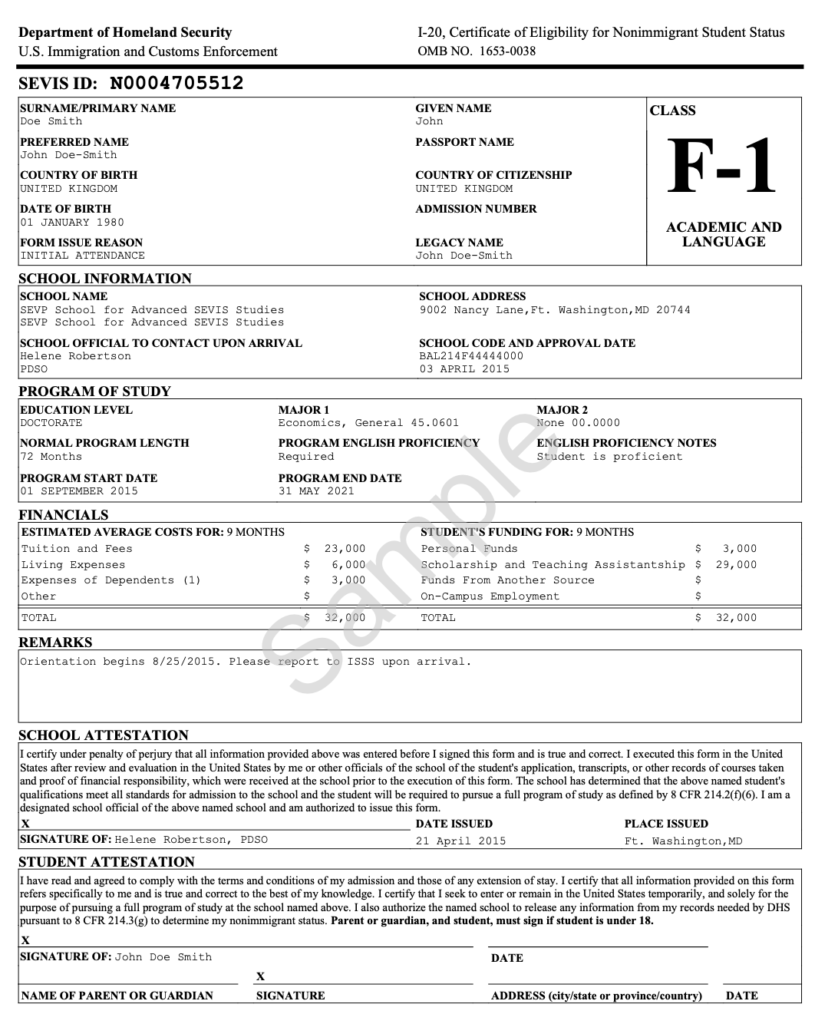What is an I-20 form? This essential document allows international students to pay the I-901 SEVIS fee, apply for a student visa at a U.S. embassy or consulate, and enter the United States to begin their studies.
What is an I-20 Form?
The I-20, known as the Certificate of Eligibility for Nonimmigrant Student Status, serves as proof that an international student has been accepted by an accredited U.S. institution and is financially prepared to complete their studies. Students use this document to pay the mandatory I-901 SEVIS fee, apply for a student visa, and travel to the U.S.
The form includes vital information such as the student’s SEVIS ID, academic program details, financial resources, and the cost of attendance.
Importance of I-20 in Visa Application
After receiving the I-20 form from a Designated School Official (DSO) at the institution they plan to attend, students must pay the SEVIS fee, which activates their SEVIS record. This record, along with the I-20 form, is required during the visa interview at a U.S. embassy or consulate.
Visa officers use the I-20 form to verify the student’s intended program, finances, and duration of stay. Students should retain the form throughout their studies, as it is required for re-entry to the U.S. after travel and for other purposes, such as applying for a Social Security Number or a driver’s license.
I-20 Form Details
| Section | Description |
|---|---|
| What is an I-20 Form? | The Certificate of Eligibility for Nonimmigrant Student Status, needed for F-1 or M-1 student visas. |
| Issued by | Designated School Official (DSO) at a U.S. SEVP-approved institution. |
| Purpose | Provides proof of admission to a U.S. institution; required for visa application and entry into the U.S. |
| Key Information Included | Student’s SEVIS ID, program start and end dates, financial details, and student’s intended course of study. |
| SEVIS Number | Unique ID for tracking students and exchange visitors. |
| Requirements | Proof of acceptance, financial resources, and supporting documents (such as passport) for issuance. |
| Importance | Needed for visa interview, entry into the U.S., and throughout the duration of the student’s stay. |
| How to Keep It Updated | Report any major changes (such as program length or funding) to the DSO to ensure SEVIS reflects updates. |
Types of I-20
U.S. universities issue two types of I-20 forms to international students, which are specific to the type of student visa required:
- F-1 I-20 Form:
- Issued to students enrolling in academic or language training programs.
- Serves as a certificate of eligibility for the F-1 nonimmigrant visa, allowing students to study in academic and language institutions.
- M-1 I-20 Form:
- Issued to students accepted into vocational or technical programs.
- Acts as a certificate of eligibility for the M-1 nonimmigrant visa, which is specific to vocational or non-academic courses.
I-20 Document for International Students
For international students planning to study in the U.S., the I-20 form is a critical document in the student visa process. Provided by U.S. colleges and universities approved by the Student and Exchange Visitor Program (SEVP), the I-20 form certifies a student’s acceptance into a full-time educational program. This form is essential for securing an F-1 or M-1 student visa, confirming the student’s eligibility and financial readiness for study in the U.S.
I-20 Form Sample

You can download the sample I-20 form pdf
Information Included in the SEVIS (Student and Exchange Visitor Information System)
When issued, the I-20 form’s information is entered into SEVIS, which tracks and manages student visa information. Key data included in SEVIS are:
- Financial Sources: Lists the student’s sources of funding for tuition and living expenses.
- SEVIS ID Number: A unique ID assigned by the university.
- Program Details: Specifies the program the student will pursue.
- Personal Information: Includes the student’s personal details for identification and verification.
- Program Duration: The official start and end dates for the academic or vocational program.
- Tuition and Fees: Details the cost of the program for which the student is enrolled.
This information enables visa officials to verify the student’s eligibility and program status throughout their study duration in the U.S..
Regardless of type, both forms include similar information but are tailored to the specific academic path. To receive an I-20, students must first be accepted by an SEVP-certified institution and demonstrate sufficient financial resources to support their education and living expenses while in the U.S..
SEVIS Fee and Visa Interview
Paying the I-901 SEVIS fee is a necessary step following the issuance of the I-20 form. This fee supports the maintenance of the SEVIS database, which tracks students throughout their studies. Proof of SEVIS fee payment is required at the visa interview.
Students should keep a copy of this payment receipt and bring it along with their I-20 form to present at the interview and upon entry to the U.S..
Who Needs the I-20?
An I-20 form is required for:
- First-time international students applying for an F-1 or M-1 visa.
- Students transferring to a different U.S. institution.
- Nonimmigrant students seeking a change to F-1 or M-1 status.
- Returning students re-entering the U.S. after an extended leave of more than five months.
The I-20 form is a key document throughout the academic journey of international students in the U.S., supporting visa applications, travel, and other legal processes that arise during their studies.
Can You Get a New I-20 Form?
Yes, if your Form I-20 is lost, damaged, or if there are updates to your SEVIS status or personal information, you can request a new copy. Here are the main instances when a new I-20 may be needed:
- Lost or Damaged Form: If your I-20 is lost, stolen, or physically damaged, you can request a new one.
- Travel Purposes: An updated I-20 may be necessary if you are planning international travel.
- SEVIS Status Changes: When your SEVIS status changes (e.g., from initial to active), you may require a reissued form.
- Updates to Personal Information: If there are changes in your academic program or your employment authorization (e.g., OPT), a new I-20 will reflect these updates.
To request a new Form I-20, contact your designated school official (DSO), who can reissue an I-20 when your SEVIS status is either initial or active
Is the I-20 Form Required for Travel?
While you don’t need your I-20 for domestic travel, it’s crucial to carry it when traveling internationally. For re-entry into the U.S., a physical copy of your I-20 with the original signatures is required for all F-1 and M-1 visa holders. Before leaving the U.S., make sure you have a recent travel endorsement on your I-20, as it must be signed by your DSO for re-entry into the country.
FAQs on the I-20 Form
What is the I-20 Form?
The I-20, or Certificate of Eligibility for Nonimmigrant Student Status, is a document issued to international students by U.S. schools that are approved by the Student and Exchange Visitor Program (SEVP). It confirms a student’s acceptance to a U.S. school and is required for obtaining a student visa.
Why do I need the I-20 Form?
The I-20 is necessary for paying the I-901 SEVIS fee, scheduling a visa interview, applying for a student visa, and entering the United States. You’ll also need it for your visa interview and for travel in and out of the U.S. during your studies.
How do I get my I-20 Form?
After being accepted by a U.S. school, you’ll work with the school’s Designated School Official (DSO) to complete required information, such as proof of financial resources. Once verified, the school will issue your I-20 form.
What information does the I-20 Form contain?
The I-20 includes details like your SEVIS ID, personal information, program of study, start and end dates, and estimated expenses. This data helps U.S. immigration officials confirm your eligibility and purpose for entering the country.
Can I change schools or programs after receiving my I-20?
Yes, but you must notify your current school’s DSO if you plan to transfer schools or switch academic programs. They will help update your SEVIS record and provide you with a new I-20 if needed.
What should I do if I lose my I-20 Form?
Contact your school’s DSO immediately to request a replacement. You should always keep the most recent I-20 safe and carry it when traveling internationally.
Does the I-20 Form expire?
The I-20 is valid for the duration of your study program as indicated on the form. If you need more time to complete your program, work with your DSO to apply for a program extension before the end date on the form.
Do I need to carry my I-20 Form when traveling internationally?
Yes, always carry your I-20 with you when entering or leaving the United States. Immigration officials will need to review it along with your visa.
Who can I contact with questions about my I-20 Form?
For questions about your I-20, reach out to the DSO at your U.S. school. They handle all matters related to SEVIS and can assist with any updates or issues regarding your I-20.


